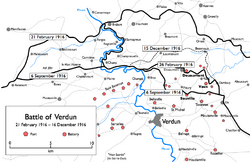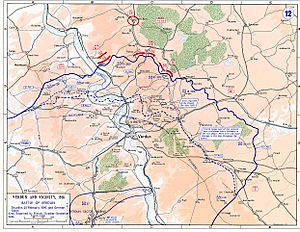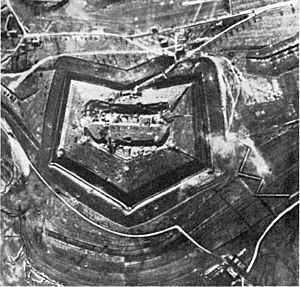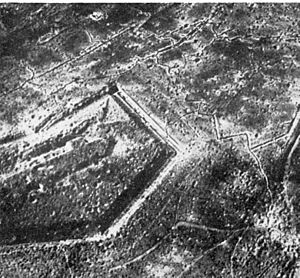Battle of Verdun facts for kids
Quick facts for kids Battle of Verdun |
|||||||
|---|---|---|---|---|---|---|---|
| Part of the Western Front of the First World War | |||||||
 Map of the battle |
|||||||
|
|||||||
| Belligerents | |||||||
| Commanders and leaders | |||||||
|
|
||||||
| Strength | |||||||
| c. 50 divisions | 75 divisions | ||||||
| Casualties and losses | |||||||
|
336,000–355,000 casualties
|
379,000–400,000 casualties
|
||||||
The Battle of Verdun was a very long and tough battle fought during the First World War. It took place in France, near the town of Verdun-sur-Meuse, from February 21 to December 18, 1916. This battle was one of the longest and most costly in human history. The German army attacked the French defenses, hoping to wear down the French army. However, the French fought back fiercely, and the battle became a symbol of their strong will.
Why the Battle of Verdun Happened
The War So Far
After the German army was stopped at the First Battle of the Marne in 1914, the war on the Western Front became a trench war. Both sides built strong defenses and tried to break through the other's lines. Many attacks in 1914 and 1915 failed and cost many lives.
Germany's Plan for Verdun
The German Chief of Staff, Erich von Falkenhayn, believed that Germany might not win the war with one big battle. Instead, he thought they could defeat the French army by causing them to lose many soldiers. He planned an attack on Verdun, a French town with strong forts. Falkenhayn hoped that France would send all its reserve troops to defend Verdun. Then, these French troops would be badly hurt while attacking strong German positions.
Verdun was important because it was in a "salient" (a part of the battle line that sticks out). This meant it could be attacked from three sides. The French had removed many guns and soldiers from the Verdun forts in 1915, thinking they were not as important anymore. This made Verdun seem like an easier target for the Germans.
Verdun's Forts and Defenses
Verdun had been a key defensive spot for France for hundreds of years. It had a citadel (a strong fortress) and two rings of 28 forts and smaller strongholds. These forts were built on high ground, overlooking the river valley.
Many of the forts, like Fort Douaumont, were modernized. They had thick, steel-reinforced concrete roofs and were buried under layers of earth to protect them from artillery. The forts were designed to support each other and had many guns in turrets that could be pulled back for protection. They also had machine guns to defend the ditches around them.
However, by February 1916, many of Verdun's forts had been weakened. Guns and ammunition had been moved to other parts of the front. Fort Douaumont, for example, had only a small maintenance crew and some of its guns had been removed. This made the forts less ready for a big attack.
Getting Ready for Battle
German Preparations
The Germans prepared for the attack very carefully. They moved thousands of kilometers of telephone cables, brought in huge amounts of ammunition and food, and set up hundreds of hidden guns. They also built new railway lines and large underground shelters for their soldiers.
The German army brought in many experienced troops and new recruits. They gathered 1,201 guns, most of which were heavy artillery. These powerful guns could fire into Verdun from three different directions. The plan was to use this massive artillery to destroy French defenses before the infantry (foot soldiers) attacked.
French Preparations
In 1915, the French had removed many guns from the Verdun forts. This left the forts with small crews and less ammunition. General Joseph Joffre, the French Commander-in-Chief, thought a German attack on Verdun would just be a distraction.
However, French intelligence learned about the German plans for Verdun. Finally, Joffre sent more troops to Verdun. By the time the German attack began, the French had 388 field guns and 244 heavy guns. This was still much less than the Germans had.
When the battle started, General Philippe Pétain took command of the French defense at Verdun. He ordered that there would be no retreat. He also made sure that the remaining forts were fully manned and supplied. More French divisions arrived, increasing their strength.
The Battle Begins
First Days: February 21 – March 1
The German attack, called Unternehmen Gericht (Operation Judgement), started on February 21, 1916. It began with a massive 10-hour artillery bombardment. Over 800 German guns fired about one million shells along a 30-kilometer front. The sound of the explosions could be heard 160 kilometers away!
After the bombardment, German stormtroopers attacked. They used flamethrowers and hand grenades. The Germans advanced quickly, capturing Fort Douaumont within the first three days. This was a big shock to the French, as Douaumont was the largest fort. The Germans found the fort mostly empty, with only a small crew inside.
By February 26, the Germans had advanced 3 kilometers on a 10-kilometer front. Both sides suffered many casualties. The French lost about 24,000 men, and the Germans lost about 25,000. French counter-attacks to retake Fort Douaumont failed.
The German advance then slowed down. The weather turned bad, making the ground muddy and difficult for moving artillery. French reinforcements also arrived, making their defense stronger. The Germans were also now within range of French artillery on the west side of the Meuse River, which caused them more casualties.
Fighting on the West Bank: March 6 – April 15
The French artillery on the west bank of the Meuse River was causing many problems for the Germans. So, the Germans decided to attack the west bank to silence these guns. They aimed to capture hills like Le Mort Homme (Dead Man's Hill) and Côte 304.
The Germans launched a new attack on March 6. They used heavy bombardments to try and destroy the French positions. The fighting for these hills was very intense and costly for both sides. The Germans captured parts of Mort-Homme and Côte 304, but the French fought fiercely to hold their ground.
By the end of March, the Germans had suffered over 81,000 casualties. The fighting on the west bank showed that capturing one important spot wasn't enough. They always needed to capture another hill to protect the first one, making it a never-ending fight.
Later Stages of the Battle
Attacks and Counter-attacks: April 16 – July 1
The battle continued with many local attacks and counter-attacks. Both sides tried to gain small advantages. The Germans continued to use their powerful artillery, but the French also had strong artillery that caused many German casualties.
In May, General Robert Nivelle took over the French Second Army at Verdun. He ordered a counter-attack on Fort Douaumont. The French managed to get inside the fort, but German reserves quickly surrounded them, forcing them to surrender. This attack was very costly for the French, who lost over 5,600 men.
Later in May, the Germans shifted their attacks back to the east bank. They aimed to capture Fort Vaux, another important fort. After a fierce assault, the Germans captured the top of Fort Vaux on June 2. The French garrison inside fought underground for days until they ran out of water and surrendered on June 7.
On June 22, the Germans used a new type of gas shell, Diphosgene, against French artillery positions. This caused many casualties and silenced some French guns. The next day, the Germans attacked again, pushing deep into French lines. They came very close to the Verdun citadel. However, the French quickly recaptured some lost ground, and the German advance was stopped. The fighting for the village of Fleury-devant-Douaumont was especially brutal, changing hands sixteen times between June and August.
The Final Push: July 1 – December 17
By July, both sides were exhausted. The Germans had to move some of their artillery away from Verdun to fight in other battles, like the Battle of the Somme. This helped the French, as the German attacks became less strong.
In September and December, the French launched their own big counter-offensives. They used massive artillery bombardments to soften up German positions. On October 24, 1916, the French attacked to retake Fort Douaumont. French marines and colonial infantry recaptured the fort. They also took many prisoners and guns.
The French continued their attacks. On November 2, the Germans evacuated Fort Vaux after a huge explosion. The French then re-occupied it. By November, the French had pushed the front line back to where it was in February.
The Second Offensive Battle of Verdun began on December 15. The French, led by General Charles Mangin, launched another huge attack after a six-day bombardment. The German defenses collapsed, and the French recaptured all the important observation points and ground they had lost in February. They took over 11,000 prisoners and 115 guns. The closest German point to Verdun was pushed back 7.5 kilometers.
Aftermath of the Battle
Casualties and Impact
The Battle of Verdun was one of the longest and bloodiest battles in history. It lasted for 302 days. Historians estimate that the French suffered about 377,000 to 400,000 casualties (killed, wounded, or missing), and the Germans suffered about 336,000 to 355,000 casualties. This means over 700,000 soldiers were lost in total.
For France, the Battle of Verdun became a powerful symbol of the French army's determination and sacrifice during the war. It showed their refusal to give up, famously captured by the phrase "They shall not pass" (Ils ne passeront pas).
Remembering Verdun
Verdun is a very important place for remembering the First World War in France. It's like how the Battle of the Somme is remembered in the United Kingdom. Many memorials were built on the battlefield.
Six French villages in the area were completely destroyed and were never rebuilt. They are now known as "uninhabited communes." The battlefield itself is still a vast graveyard, with the remains of over 100,000 missing soldiers. Many of these remains are now in the Douaumont ossuary, a building that holds the bones of soldiers from both sides.
In recent times, Verdun has become a symbol of peace and friendship between France and Germany. In 1984, the German Chancellor Helmut Kohl and French President François Mitterrand met at the Douaumont cemetery. They held hands in the rain, showing how the two countries had reconciled after the wars.
Images for kids
- List of French villages destroyed in World War I
- Rue Verdun, Beirut, Lebanon
- Voie Sacrée
- Moulin de Rouvres
See also
 In Spanish: Batalla de Verdún para niños
In Spanish: Batalla de Verdún para niños










